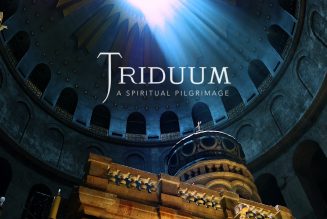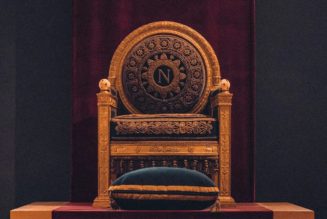 |
Something is stirring in England. It’s not much. A still, small voice of calm whispering in the dark. Prayers ascending like incense. A rekindled faith.
No, it’s not much. Merely a mustard seed.
It won’t be noticed by most people. It will go unheeded by the dead men milling around satanically in what remains of England’s once green and pleasant land. And yet it stirs the restless hearts of those Englishmen who have languished in the hope of England’s return to the Faith, longing for the return of the exiled “Pilgrim Queen” of whom St. John Henry Newman wrote:
“Here I sit desolate,”
sweetly said she,
“Though I’m a queen,
and my name is Marie:
Robbers have rifled
my garden and store,
Foes they have stolen
my heir from my bower.
The Pilgrim Queen is Our Lady of Walsingham, whose shrine, nestled in a Norfolk village, was once one of the major places of pilgrimage in the whole of Christendom. She was England’s queen and England was her dowry. Such was the pious belief of the English people in the days of Merrie England. Then came the monster, Henry VIII, who destroyed the shrine and the abbeys clustered around it. After three centuries of brutal persecution, it seemed as though Henry’s iconoclastic legacy was the destruction of the Faith itself in England. Only the recusant remnant remained: a few thousand noble souls whose families had passed on the Faith, generation to generation, across the abyss of centuries of religious persecution. A few, a happy few.
Then, when all seemed lost, the conversion of John Henry Newman in 1845 heralded a new Catholic revival. For the next century or so, tens of thousands of adult converts crossed the Tiber, notable among whom were the likes of Gerard Manley Hopkins, Oscar Wilde, G.K. Chesterton, Ronald Knox, Evelyn Waugh, Graham Greene, Alec Guinness, and Malcolm Muggeridge. After Vatican II, this exciting and exhilarating revival seemed to falter and fall.
And now, when all once again seems lost, something is once again stirring.
Over the past two years, the statue of Our Lady of Walsingham has been traveling the length and breadth of the country, visiting every one of England’s Catholic cathedrals. The Pilgrim Queen, long in exile, has returned and is the inspiration and the focus of a mission to pray for the re-evangelisation of England and her conversion.
Known as the Dowry Tour, in recognition of England’s traditional title as Our Lady’s Dowry, the Queen’s pilgrimage to all four corners of her realm has been accompanied by an invitation to all Catholics in England to renew their personal consecration to Our Lord and Our Lady. They are doing this in their local parishes through communal acts of preparation for consecration to Jesus through Mary, accompanied by pledges to go to regular Confession and to pray the Angelus and rosary, in communion with the saints and martyrs of England through their invocation.
On February 21, England’s Catholics began a personal 33-day consecration to Jesus through Mary following the method of St. Louis de Montfort, which will conclude on March 25, the feast of the Annunciation. Four days later, on March 29, England will be formally rededicated to Mary at Westminster Cathedral in London, at Walsingham, at all the other cathedrals of England, and in many parishes and homes. This ceremony follows the original dedication of England to Our Lady by Richard II in 1381, a high point in English history depicted by the famous Wilton Diptych, one of the masterpieces of late mediaeval art.
England’s rediscovery of her Catholic roots and the rededication of the country to the exiled Pilgrim Queen are causes for great joy, as are the prophecies about England’s future made by two nineteenth-century saints, as reported by Donal Anthony Foley in the UK’s Catholic Herald earlier this month. When St. John Vianney, the Curé d’Ars, was visited by Archbishop Ullathorne of Birmingham in 1854, the saint declared to the archbishop, “as though he were making an act of faith,” that he believed that the Church in England would recover its ancient splendor. Similarly, St. Dominic Savio, the protégé of St. John Bosco, asked Don Bosco in 1856 to pass on a message to the reigning pope, Pius IX, that “he should not lessen his special care for England [because] God is preparing a great triumph for the Church in that country.” In explanation, St. Dominic told St. John Bosco that he had received a vision in which he saw a misty plain, and heard a voice declaring that “this is England.” He saw a figure wearing pontifical robes coming towards him, holding a huge, flaming torch in his hand. The same voice told him that “this torch is the Catholic faith which is to illumine England.”
One other saint who had a vision of the restoration of the Faith in England was St. John Henry Newman. This is how he concludes his poem, “The Pilgrim Queen”:
I look’d on that Lady,
and out from her eyes
Came the deep glowing blue
of Italy’s skies;
And she raised up her head
and she smiled, as a Queen
On the day of her crowning,
so bland and serene.
“A moment,” she said,
”and the dead shall revive;
The giants are failing,
the Saints are alive;
I am coming to rescue
my home and my reign,
And Peter and Philip
are close in my train.”
It takes great faith to believe that the splendor of the Catholic faith can ever be restored to a nation which has strayed so far from the goodness, truth and beauty which comes from God. It might take more than great faith; it might even take a miracle. It will certainly require the intercession of the saints, as well as the prayers of the greatest of all the saints.
Our Lady of Walsingham, Pilgrim Queen, pray for the conversion of England.
Photo credit: Catholic News Agency









